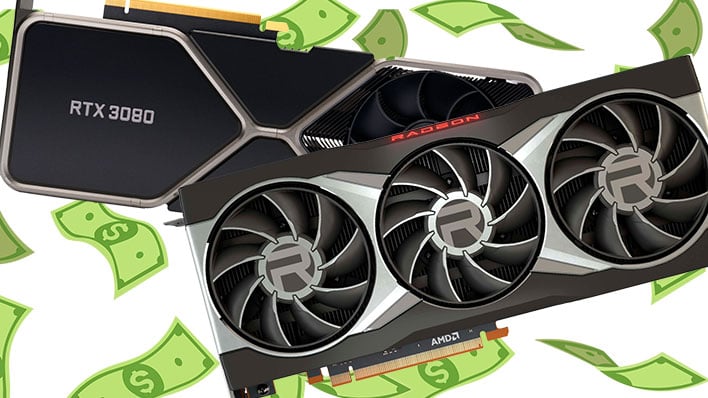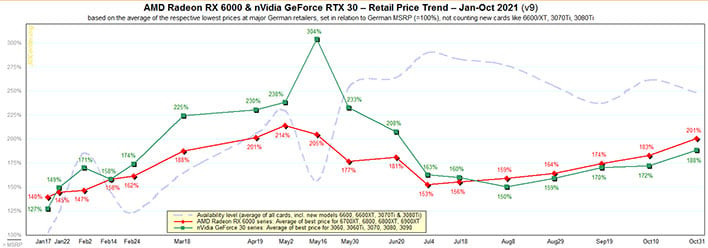NVIDIA GeForce RTX And AMD Radeon RX GPU Prices Trending Back To Record Highs

I had not intended on writing about the continued upward trend of GPU prices at the conclusion of October, because it is starting to feel like beating a dead horse. It's not something I particularly enjoy pointing out, and by now, we all know the situation. So why am I? What I had not necessarily anticipated is that certain models would come close to reaching all-time highs.
Turns out that graphics card price trends through Halloween were the real scare. This is unfortunate because after spiking to yearlong highs in April and May, GPU street prices fell sharply over the course of several weeks, before gradually ascending again. And it's been that way ever since, only now, AMD's Radeon RX 6000 series has nearly hit its previous high. Here's a look...
This is not an all-inclusive picture, but the data is at least consistent—3DCenter has been tracking and graphing the actual cost (read: not MSRPs, which are pipe dreams) of the latest generation GPU models across retailers in Germany and Austria, and there are notable peaks in late April and mid-May. Towards the tail-end of April, Radeon RX 6000 series card were selling for 114 percent above MSRP, while in May, GeForce RTX 30 series cards were commanding 204 percent above list price.
Inflated retail pricing began to free fall after peaking earlier this year, then embarked on a slow ascent. And now? The tracking data indicates that Radeon RX 6000 series cards are selling for 201 percent above MSRP, which is just a few measly percentage points below the previous high point.
The market being what it is, there are seemingly strange occurrences arising from the shortage. For example, the Radeon RX 6800 sometimes fetching a higher price than the flagship Radeon RX 6900 XT. It just boils down to whatever is actually available at any point in time.
As for NVIDIA, the GeForce RTX 30 models tracked are selling for around 88 percent above MSRP these days. That's well below the peak in May, but if the slope holds up, Ampere could match its high in the first quarter of next year. As it stands, tracked street pricing is inflated about the same as AMD's cards (a tad less, though the GeForce RTX 30 series costs more to begin with).
So there's your updated snapshot. Meanwhile, NVIDIA could be upgrading some of its existing cards with more VRAM, if the latest rumors are true, and sometime next year Intel will enter the fray with its first Arc Alchemist models. Fingers crossed availability and pricing will calm down at some point next year.


